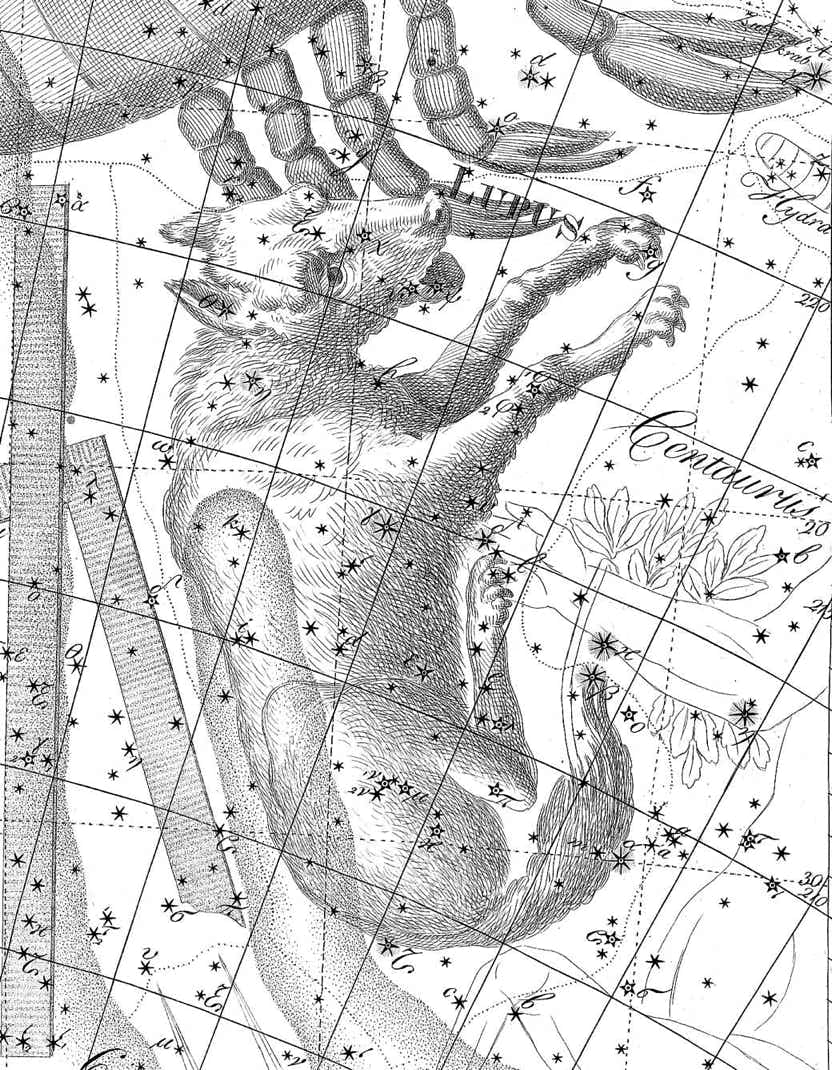
Genitive: Lupi
Abbreviation: Lup
Size ranking: 46th
Origin: One of the 48 Greek constellations listed by Ptolemy in the Almagest
Greek name: Θηρίον (Therion)
The ancient Greeks called this constellation Θηρίον (Therion), representing an unspecified wild animal, while the Romans called it Bestia, the beast. It was visualized as impaled on a long pole called a thyrsus, held by the adjoining constellation of Centaurus, the centaur. Consequently, the centaur and the animal were often regarded as a combined figure, although Ptolemy listed the animal as a separate constellation in the Almagest.
Lupus is visualized as being impaled on a pole (a thyrsus) held by
Centaurus (out of picture to the right) who is holding it out towards
Ara, the altar, as though about to sacrifice it. This illustration is
from Chart XV of the Uranographia of Johann Bode (1801).
Eratosthenes said that the centaur was holding the animal towards the altar (the constellation Ara) as though about to sacrifice it. Hyginus referred to the animal as simply ‘a victim’, while Germanicus Caesar said that the centaur was either carrying game from the woods, or was bringing gifts to the altar. The identification of this constellation with a wolf seems to have become established in Renaissance times, harking back to its Babylonian identification as UR.IDIM, meaning ‘wild dog’ or ‘wolf’.
One is tempted to recall the story of Lycaon, king of the Arcadians, who served Zeus with the flesh of the god’s own son and was punished by being turned into a wolf (see Boötes). But that story has no connection with this constellation, which seems to have been overlooked by the mythologists. The fact that it is an imported constellation probably explains why the Greeks had no myths for it.
Bayer allocated Greek letters to 20 stars in Lupus on his Uranometria atlas of 1603, but Lacaille relabelled the constellation in his Coelum Australe Stelliferum of 1763 and it is Lacaille’s letters, with some modifications, that we still use today. Alpha Lupi was officially named Uridim by the IAU in 2024, in recognition of the constellation’s Babylonian origin.
The massed stars of Lupus and Centaurus were known to the Arabs as al-shamārīkh, meaning stalks of dates, from their resemblance to the clusters of fruit on a date palm.
Chinese associations
Much of Lupus was occupied by a Chinese constellation called Qiguan, said to represent either cavalry officers or the Emperor’s guardsmen. Qiguan consisted of 27 stars, making it one of the largest Chinese constellations in terms of numbers. South of Qiguan, Kappa Lupi was Qizhenjiangjun, the cavalry general, while Zeta, Rho, and Sigma Lupi were Cheqi, representing chariots and horsemen. Following the cavalry were the infantry, represented by the 12 stars of Jizu; most of this constellation lay in neighbouring Scorpius but it included Eta and probably two other stars of Lupus. Zenche, consisting of a triangle of stars (probably 1 and 2 Lupi plus Sigma Librae), was a formation of battle chariots, while Congguan (Chi and probably Psi Lupi) was an army doctor. Together with an arsenal, Kulou, nearby in Centaurus, and other military-themed constellations to the north in Libra, this whole area conjures up a picture of troops massing for battle.
© Ian Ridpath. All rights reserved



